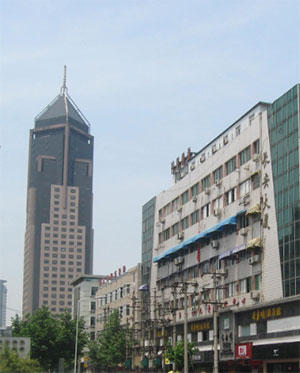
Hefei, the capital of historically poor Anhui province emerged as China's top growth center among major metropolitan areas over the past 10 years. Metropolitan areas from the interior, the Yangtze Delta and the central and northern coast were the fastest growing, displacing Guangdong's Pearl River Delta, long the growth center for the country. (Figure 1).
China's Trends in Context: China's growth rate has fallen substantially and the United Nations has projected that the nation will experience population decline starting between 2030 and 2035. However, China's urban areas have grown strongly as people have continued to move to cities for better opportunities. According to World Bank research, China's economic progress since 1981 has lifted more people out of poverty than ever before in the world.
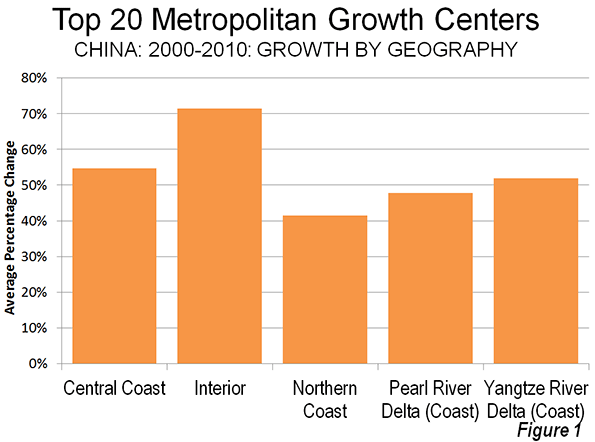
Never before in history have so many people moved to urban areas in such a short period of time.
Since the reforms began in approximately 1980, all of China's population growth has been urban. Rural areas lost approximately 110 million people between 1980 and 2010. That is approximately equal to the population of Mexico and more than each of the nations in the world except for 11. Over the same three decades, 470 million people were added to the urban areas. That is more than 1.5 times the population of the United States.
China's Metropolitan Areas: This article provides an analysis of the urban districts (qu) of Chinas urban regions (routinely mislabeled "cities"). These districts are designated by regional officials as urban for urban development. Since the peripheral urban districts are principally rural, the combination of urban districts (Shi Shixiaqu)in a region are akin to a metropolitan area (labor market area).
Among the metropolitan areas that began the decade (2000) with more than 1,000,000 inhabitants, the slowest 10 year growth rate was 36 percent. In comparison, among the 51 US metropolitan areas with more than 1,000,000 population, only three (Las Vegas, Raleigh and Austin) would have placed in China's top 20, and not higher than 14th (Table). As in the US, the most rapid urban growth is taking place in smaller metropolitan areas with less than 5 million in 2010.
| Top 20 Metropolitan Growth Centers in China: 2000-2010 | ||||||
| Rank | Metropolitan Area | 2000 Population | 2010 Population | Change | % | Geography |
| 1 | Hefei, AN | 1,659,000 | 3,352,000 | 1,693,000 | 102.0% | I |
| 2 | Xiamen, FJ | 2,053,000 | 3,531,000 | 1,478,000 | 72.0% | C |
| 3 | Zhengzhou, HEN | 2,560,000 | 4,254,000 | 1,694,000 | 66.2% | I |
| 4 | Suzhou, JS | 2,473,000 | 4,074,000 | 1,601,000 | 64.7% | Y |
| 5 | Wenzhou, ZJ | 1,916,000 | 3,040,000 | 1,124,000 | 58.7% | Y |
| 6 | Ningbo, ZJ | 2,201,000 | 3,492,000 | 1,291,000 | 58.7% | Y |
| 7 | Urumqi, XJ | 1,753,000 | 2,744,000 | 991,000 | 56.5% | I |
| 8 | Weifang, SD | 1,380,000 | 2,044,000 | 664,000 | 48.1% | N |
| 9 | Shenzhen, GD | 7,009,000 | 10,358,000 | 3,349,000 | 47.8% | P |
| 10 | Hangzhou, ZJ | 4,243,000 | 6,242,000 | 1,999,000 | 47.1% | Y |
| 11 | Beijing, BJ | 12,874,000 | 18,827,000 | 5,953,000 | 46.2% | N |
| 12 | Changsha, HUN | 2,123,000 | 3,094,000 | 971,000 | 45.7% | I |
| 13 | Chengdu, SC | 5,268,000 | 7,677,000 | 2,409,000 | 45.7% | I |
| 14 | Shanghai, SH | 15,758,000 | 22,315,000 | 6,557,000 | 41.6% | Y |
| 15 | Hohhot, NM | 1,407,000 | 1,981,000 | 574,000 | 40.8% | I |
| 16 | Nanjing, JS | 5,098,000 | 7,166,000 | 2,068,000 | 40.6% | Y |
| 17 | Shijiazhuang, HEB | 1,970,000 | 2,767,000 | 797,000 | 40.5% | N |
| 18 | Fuzhou, FJ | 2,124,000 | 2,922,000 | 798,000 | 37.6% | C |
| 19 | Qingdao, SD | 2,721,000 | 3,719,000 | 998,000 | 36.7% | N |
| 20 | Tianjin, TJ | 8,146,000 | 11,090,000 | 2,944,000 | 36.1% | N |
| Metropolitan areas with more than 1,000,000 population in 2000. | ||||||
| Metropolitan areas consist of urban districts (qu) | ||||||
| Geographical Codes | ||||||
| C | Central Coast | |||||
| I | Interior | |||||
| N | Northern Coast | |||||
| P | Pearl River Delta (Coast) | |||||
| Y | Yangtze River Delta (Coast) | |||||
| Data from National Bureau of Statistics of China | ||||||
The Interior: Six of the top 20 gainers were in the interior, including fastest growing Hefei. This reflects the appeal of lower labor costs and perhaps also that rural migrants often prefer to work in regions closer to their homes and families in agricultural regions. These six metropolitan areas had an average growth rate of 71 percent, the largest rate of any geographical grouping.
- The capital of Anhui province, Hefei (photo), had the largest gain, at 102 percent. Hefei grew from 1.659 million to 3.352 million. Hefei is developing one of the most dispersed urban forms among China's metropolitan area and there continues to be considerable construction. Hefei's population growth rate was nearly one-half more than of second place Xiamen. Anhui is one province removed from the coast and Hefei is only 115 miles (185 kilometers) from the Yangtze Delta's Nanjing.
- The third ranked metropolitan area was Zhengzhou (photo), the capital of Henan province (also separated from the coast by one province), which experienced a 66 percent population gain.
- Urumqi, the capital of China's large northwestern province of Xinjiang ranked 7th with a gain of 57 percent. Urumqi is by far the most remote from the East Coast of the large gainers (2,000 miles or 3,250 kilometers from Tianjin, near Beijing).
- Other interior fast growers were Changsha, capital of Hunan (12th, with 46 percent growth), Chengdu, the capital of Sichuan ranked 13th, with 46 percent growth and Hohhot, capital of Nei Mongol (Inner Mongolia), ranked 15th, with a growth rate of 41 percent.
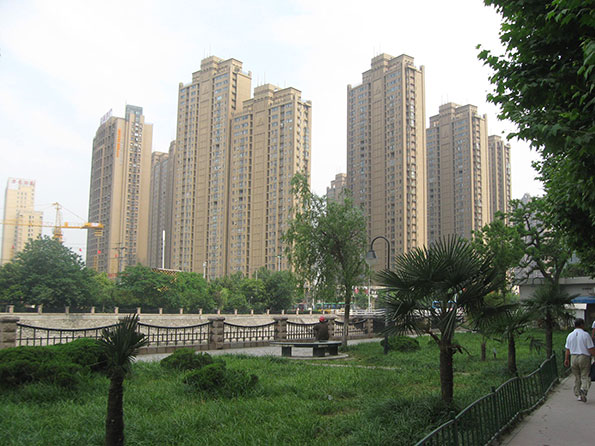
Hefei
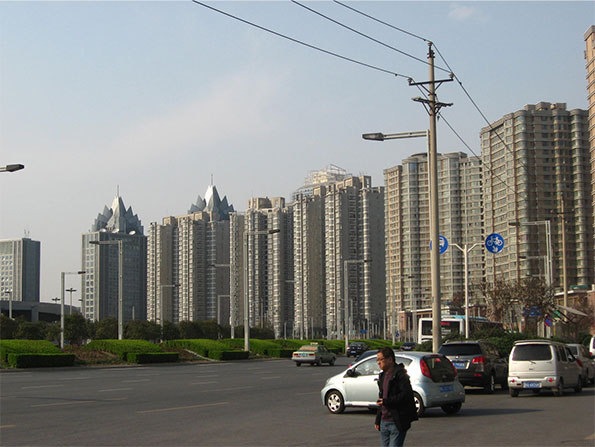
Zhengzhou
Central Coast: Xiamen (photo), one of the first special economic zones designated after Shenzhen and placing 2nd in growth, added 72 percent to its population. This metropolitan area is centered on an island in Fujian province on China's central coast, less than 10 miles from to Jinmen (Quemoy), an island controlled by Taiwan. Fuzhou, the capital of Fujian province was another central coastal metropolitan area among the top 20 growth centers (18th, at 38 percent). The average growth rate of these metropolitan areas on the central coast was 55 percent.
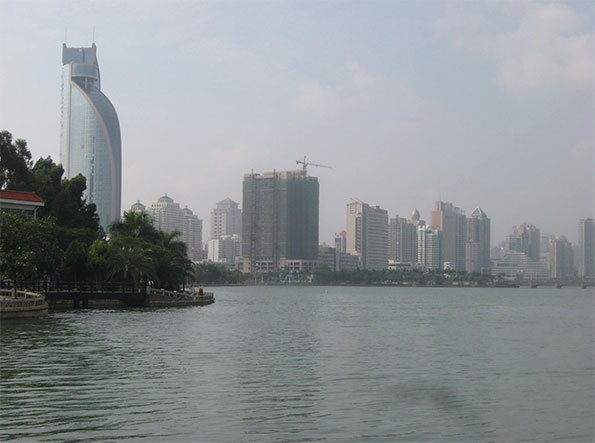
Xiamen
Yangtze River Delta: Like the interior, the Yangtze River (Changjiang) Delta also placed six metropolitan areas among the top 20 growth centers. The average growth rate was 52 percent. The Yangtze River Delta is a large area with a population greater than that of the Pearl River Delta, but with urban regions that are separated from one another by considerable rural territory (unlike the Pearl River Delta). The exception is the Shanghai-Suzhou-Wuxi corridor (Note), where the urbanization is continuous in limited corridors.
- Suzhou (Photo), part of which (Kunshan qu) abuts Shanghai ranked as the third fastest growing metropolitan area, with a growth rate of 65 percent. Suzhou added 1.6 million people and is nearing 4.1 million. As the growth of Shanghai continues to spill westward and northward, Suzhou is likely to continue its strong growth.
- The other three top 10 metropolitan growth areas in the Yangtze River Delta were in the province of Zhejiang, including Wenzhou at 5th, growing 59 percent (Photo), Ningbo, one of the nation's largest ports was 6th, at 59 percent and Hangzhou, the provincial capital, which Marco Polo claimed was the largest city in the world in his Travels was 10th, at 47 percent.
- Shanghai, the nation's largest metropolitan area, placed 14th in growth, at 42 percent. Shanghai had the largest numeric growth, adding 6.6 million to its population, more people than live in Toronto.
- Nanjing, the capital of Jiangsu province ranked 16th in growth, at 41 percent.
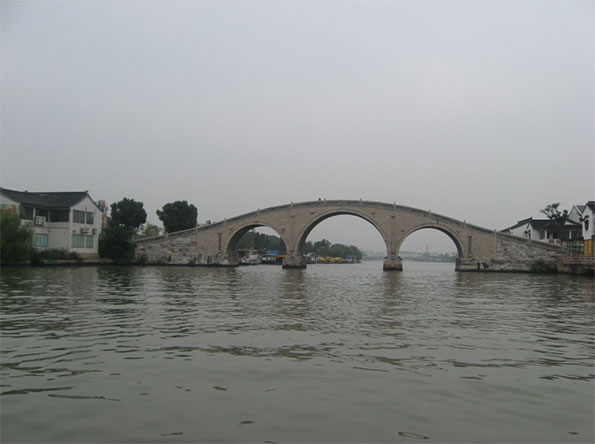
Suzhou
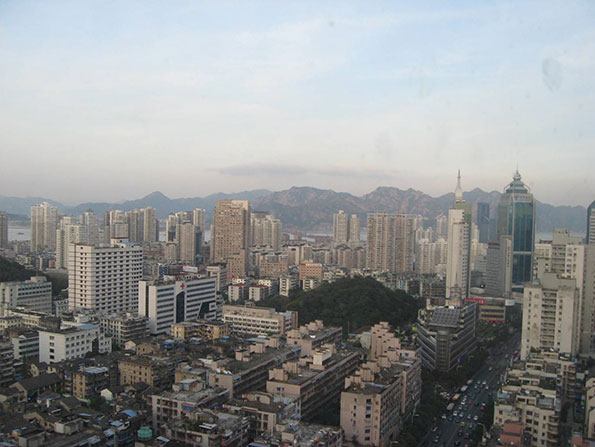
Wenzhou
Northern Coast: Five northern coastal metropolitan areas were among the top 20 metropolitan gainers, with an average growth rate of 42 percent.
- Weifang, in the province of Shandong ranked 8th in growth, the highest rating among metropolitan areas in the northern coastal area. Weifang added 48 percent to its population.
- Beijing ranked 12th in growth, at a 46 percent rate. Beijing's numeric growth was second only to Shanghai, at 6 million.
- The other northern coastal growth centers were Shijiazhuang, the capital of Hebei (17th, at 41 percent) and 175 miles (280 kilometers), south of Beijing. Qingdao, of brewing fame ("Tsingtao" beer) ranked 19th, with a growth rate of 37 percent, while Tianjin, which is close enough to be Beijing's port, ranked 20th, with a growth rate of 36 percent.
Pearl River Delta: In contrast the Pearl River Delta, the home of so much urban growth over the past 30 years, placed only one metropolitan area among the top 20 growth centers, Shenzhen. Shenzhen placed 9th, with a growth rate of 48 percent. This is in stark contrast to 1990 to, when Shenzhen and adjacent Dongguan both more than doubled in population.
Missing Giants: Chongqing was not among the top growth centers. Chongqing has been routinely mischaracterized as China's largest metropolitan area (because of semantic confusion over the word "city"). Chongqing's metropolitan districts grew only 22 percent and the region (a provincial equivalent) lost population. Neighborhood rival Chengdu, capital of Sichuan province from which Chongqing was separated in 1996 more than doubled its growth rate. Manchuria, China's "Dongbei" (Northeast) also failed to place any areas among the fastest growing. Shenyang, the center of China's Rust Belt, grew less than 10 percent, though Harbin, capital of Helonjiang grew nearly 30 percent.
More Growth to Come: Despite an overall population that is just peaking, urban population growth is expected to be substantial. In addition to the 470 million people that have moved to urban areas since 1980, the United Nations projects that another 340 million people will be added to the urban areas by 2045 (after which a modest decline is expected). Over the same 35 years, China's rural population is expected to fall by 387 million (Figures 2 and 3). Where these new migrants move and how they make do will be among the most important urban stories of the next decade.
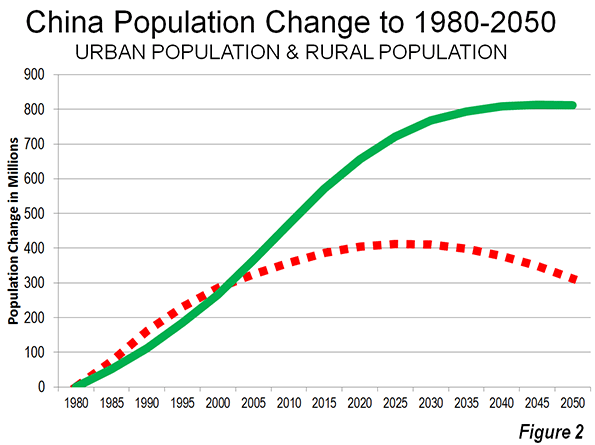
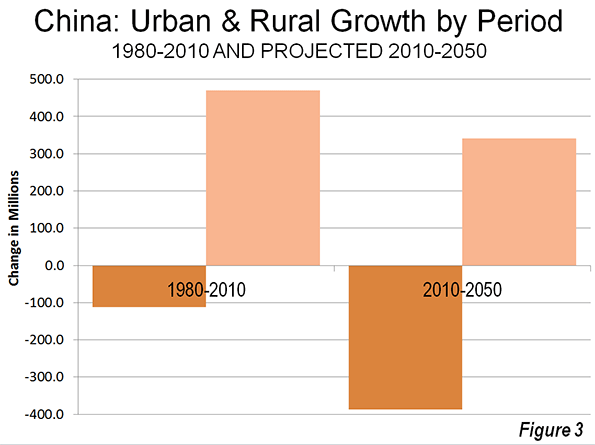
Wendell Cox is a Visiting Professor, Conservatoire National des Arts et Metiers, Paris and the author of “War on the Dream: How Anti-Sprawl Policy Threatens the Quality of Life”.
-------
Note: Includes Kunshan, part of the Suzhou metropolitan area, but a separate urban area (between the Suzhou urban area and the Shanghai urban area).
Note: Corrected Hefei data on 6/3/2012.
Top photo: Hefei: All photos by author.













Excellent website you have
Excellent website you have here, so much cool information!..
www.kusi.com/story/28001863/reverse-my-tinnitus-review-evaluates-dr-phillips-and-alan-watsons-diet-based-tinnitus-treatment
Good perspective on China
This article has given good perspective on China from various angles with full information and clear explanation. This is quite good for Indian students of history. www.price4india.co.in lowest also has similar geography articles.
great post
excellent. one of the best articles I have every read. This is the information which I have been searching. Great information. Ecopolitan EC | Ecopolitan EC price | Ecopolitan | Ecopolitan Punggol | Ecopolitan Executive Condo | Sea Horizon | Sea Horizon EC | Sea Horizon Executive Condo | Sea Horizon Executive Condominium | Sea Horizon Pasir Ris | Sea Horizon EC price | Tembusu Condo | Tembusu at Kovan | Tembusu Kovan | Tembusu condo Price | Tembusu | Vue 8 residence | Vue 8 residence price | Vue 8 Condo | Vue 8 Pasir Ris | Vue 8 | the inflora | inflora condo | inflora loyang | inflora this article is worth bookmarking. keep it up !
Ultrabooks
We were able to provide you with some of the facts above but there is still plenty more to write about in subsequent articles.check cheap online booking in less rates Ultrabooks
favorite offensive and defensive drills
Whenever coffee espresso beans are roasting nevertheless, a critical this essential component is destroyed consequently reducing the great consequences of coffee. favorite offensive and defensive drills
bong shop
I must thank you for the efforts you've put in penning this site. I am hoping to check out the same high-grade content by you later on as well. In fact, your creative writing abilities has inspired me to get my very own site now ;)I seriously appreciate people like you! Take care!!!come and visit bong shop
e cigs reviews
Mr Ashraf Raisulwasaraha wadanka Pakistan ayaa beeniyay dhamaan eedaymaha loo haysto ee la xidhiidha inuu gaystay falal musuq ah. e cigs reviews
Informative Post
I am really enjoying reading your well written articles. It looks like you spend a lot of effort and time on your blog. I have bookmarked it and I am looking forward to reading new articles. Keep up the good work. lenovo support
These districts are
These districts are designated by regional officials as urban for urban development. free cell phone spy software
cell phone spyware
Graphic designers Brisbane
Thank for the advice, but I always shop locally for the holidays. In this way is easier buying the right gift because my child's wishes are changing very fast. This year I want to buy a costume from the science department because I saw that my son has started enjoying science. Graphic designers Brisbane